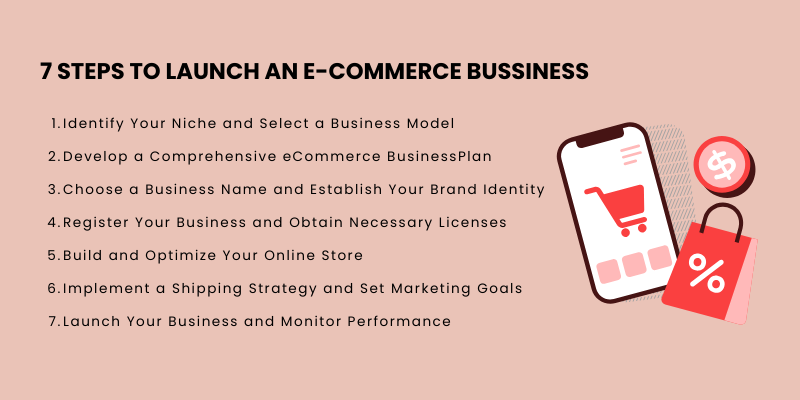Starting an e-Commerce business involves selling products or services online through a digital storefront.
Whether you are looking to sell physical goods, digital products, or services, the e-Commerce industry offers immense potential for businesses of all sizes.
The process involves choosing the right platform, setting up a reliable payment gateway, understanding how to start an ecommerce business, developing an appealing website, and effectively marketing your products to your target audience.
With millions of consumers shopping online, having a solid eCommerce strategy can help you tap into a global market and grow your business.
In 2025, the e-Commerce landscape continues to evolve, offering new opportunities and challenges for entrepreneurs.
By understanding the key steps and leveraging the right tools, you can establish a successful online presence and reach customers worldwide.
What Is an eCommerce Business?
An e-Commerce business is an enterprise that conducts commercial transactions buying and selling goods or services over the internet.
This model leverages digital platforms such as websites, mobile applications, and social media to facilitate online shopping experiences.

Customers can browse virtual storefronts, add items to digital carts, and complete purchases through secure payment gateways, all from the convenience of their devices.
eCommerce businesses encompass a wide range of operations, from small, niche shops to expansive online marketplaces, and learning how to start an ecommerce business is essential for anyone looking to enter this diverse and growing industry.
These businesses can operate under various models, including:
- Business-to-Consumer (B2C): Companies sell directly to individual consumers, such as online retailers like Amazon or fashion brands like Zara.
- Business-to-Business (B2B): Businesses sell products or services to other businesses, often in bulk or as part of a supply chain.
- Consumer-to-Consumer (C2C): Individuals sell directly to other consumers, typically through online platforms like eBay or Craigslist.
- Consumer-to-Business (C2B): Individuals offer products or services to businesses, such as freelance work or user-generated content.
- Direct-to-Consumer (DTC): Brands sell their products directly to consumers, bypassing traditional retail channels, as seen with companies like Warby Parker
The rise of e-Commerce has transformed traditional retail by enabling businesses to reach a global audience, operate 24/7, and reduce overhead costs associated with physical storefronts.
Explore Our ECommerce Marketing Services!
7 Key Steps to Launching a Successful eCommerce Business
Starting an eCommerce business involves several key steps that lay the foundation for a successful online venture.

Here's a comprehensive guide to help you navigate the process:
- Identify Your Niche and Select a Business Model
- Develop a Comprehensive eCommerce BusinessPlan
- Choose a Business Name and Establish Your Brand Identity
- Register Your Business and Obtain Necessary Licenses
- Build and Optimize Your Online Store
- Implement a Shipping Strategy and Set Marketing Goals
- Launch Your Business and Monitor Performance
Let’s explore each.
1. Identifying Your Niche and Selecting the Right eCommerce Business Model
Embarking on an eCommerce venture begins with selecting a business model that aligns with your resources, goals, and market understanding.
The model you choose will influence your operational structure, customer engagement strategies, and overall business dynamics.
Here are four prevalent eCommerce business models to consider:
-
Dropshipping
In the dropshipping model, you operate an online store without maintaining inventory.
When a customer places an order, you forward the details to a supplier who handles storage and shipping directly to the customer.
This approach minimizes upfront investment and operational costs. However, it offers limited control over product quality and fulfillment speed, which can impact customer satisfaction.
-
Direct-to-Consumer (DTC)
The DTC model involves manufacturing products and selling them directly to consumers through your own online platform, bypassing third-party retailers.
This model allows for greater control over branding, customer experience, and profit margins. However, it requires significant investment in product development, marketing, and logistics.
-
Subscription-Based
Subscription-based eCommerce offers products or services on a recurring basis, such as monthly delivery of curated items.
This model fosters customer loyalty and provides predictable revenue streams. It's particularly effective for consumables or niche products that customers need regularly.
However, it requires careful inventory and customer relationship management to maintain satisfaction and minimize churn.
-
Wholesale
Wholesale eCommerce involves purchasing products in bulk from manufacturers and selling them at a markup to retailers or directly to consumers.
This model benefits from economies of scale and can yield higher profit margins. However, it necessitates substantial upfront capital for inventory and storage, along with a robust supply chain management system.
Thus, selecting the appropriate eCommerce business model depends on various factors, including your budget, risk tolerance, and long-term objectives.
Each model offers unique advantages and challenges, so aligning your choice with your business vision is crucial for success in today’s competitive digital environment where performance marketing plays a pivotal role in customer acquisition.
Explore Our Performance Marketing Services!
2. Develop a Comprehensive eCommerce Business Plan
A well-structured business plan serves as a roadmap for your eCommerce venture, guiding your strategies and operations.
Key components include:
- Executive Summary: Provide a concise overview of your business, including your mission, vision, and the unique value proposition you offer.
- Company Overview: Detail your business model, legal structure, and the products or services you plan to offer.
- Market Analysis: Conduct thorough research to understand your target audience, market trends, and competitive landscape.
- Marketing and Sales Strategy: Outline your approach to attracting and retaining customers, including pricing, promotions, and sales tactics, and address what are five marketing strategies that retailers spend half of their annual budget on? to ensure you focus resources effectively.
- Operational Plan: Describe the logistics of your business, such as supply chain management, order fulfillment, and customer service protocols.
- Financial Projections: Provide detailed forecasts covering startup costs, revenue expectations, profit margins, and break-even analysis.
Utilizing templates from reputable sources like Shopify and BigCommerce can streamline this process and ensure you cover all essential aspects.
3. Choose a Business Name and Establish Your Brand Identity
Choosing a business name and establishing a brand identity are pivotal steps in launching a successful e-Commerce venture.
Here’s how to choose a business name and brand identity:
-
Selecting a Business Name
Begin by brainstorming names that encapsulate your brand's essence and resonate with your target market. Aim for a name that is evocative, memorable, and easy to pronounce.
Avoid names that are overly descriptive or too similar to existing brands to prevent confusion and potential legal issues.
Once you have a shortlist, verify the availability of the domain name and check for trademarks to ensure your chosen name is legally protected.
This step is crucial to avoid future conflicts and to establish a unique online presence.
-
Building Your Brand Identity
Your brand identity is the visual and emotional representation of your business. It encompasses elements like your logo, color palette, typography, and brand voice.
A cohesive brand identity communicates your values and differentiates you from competitors
Start by defining your brand's mission, values, and personality. This foundation will guide the design of your visual elements and the tone of your messaging.
Ensure consistency across all platforms, including your website, social media, and marketing materials, to build recognition and trust with your audience, a tactic often used by a luxury branding agency to create high-end consumer experiences.
For instance, companies like Nike and Starbucks have successfully created strong brand identities by aligning their visual elements with their brand values, resulting in high customer loyalty.
4. Register Your Business and Obtain Necessary Licenses
To legally operate an e-Commerce business, it's essential to follow the appropriate registration procedures:
-
Choose a Business Structure
Decide on the legal structure of your business, such as a sole proprietorship, partnership, or private limited company (Pvt. Ltd.).
-
Register with the Securities and Exchange Commission
For private limited companies, register with the Securities and Exchange Commission through their eServices portal. You'll need to submit documents like the Memorandum of Association, Articles of Association, and proof of identity.
-
Obtain a National Tax Number (NTN)
Register with the Federal Board of Revenue (FBR) to obtain an NTN, which is necessary for tax purposes. This can be done online through the FBR's portal.
-
Register for Sales Tax
If your business is liable for sales tax, register with the FBR for sales tax. This is applicable if your annual turnover exceeds the taxable limit set by the FBR.
-
Obtain a Trade License
Depending on your business's nature and location, you may need to acquire a trade license from local authorities. This ensures compliance with local regulations and also enables you to plan B2B marketing strategies if you aim to sell products to other businesses.
-
Build and Optimize Your Online Store
Select an eCommerce platform that suits your needs and budget. Popular options include Shopify, WooCommerce, and Wix. Ensure your website is user-friendly, mobile-responsive, and optimized for search engines to enhance visibility and user experience.
Explore Our Digital Marketing Services!
5. Build and Optimize Your Online Store
Building and optimizing your online store is pivotal to the success of your eCommerce business.
Here's a comprehensive guide to help you create a user-friendly, efficient, and high-converting online store
-
Platform Selection
Shopify, WooCommerce, and Wix eCommerce are three prominent platforms catering to different business needs, if you're wondering how does Shopify work, it allows you to manage products, payments, and shipping from a centralized dashboard.
-
Website Design & User Experience
Ensure your website is intuitive, mobile-responsive, and visually appealing to enhance user experience it also provides high-quality images, detailed descriptions, and customer reviews to build trust.
-
SEO Optimization
Implement SEO best practices to improve your website's visibility on search engines, driving organic traffic, google keyword ranking tools can help identify high-performing keywords for your niche and identify relevant keywords and incorporate them naturally into your content.
Also, optimize title tags and meta descriptions for better click-through rates. Additionally, if you're looking to verify content on competitor pages, knowing how to search a word on a website can help you evaluate their keyword strategy and product details efficiently.
-
Payment Integration
Offer multiple payment options, including credit/debit cards, bank transfers, and mobile wallets, to cater to a wide customer base and Use SSL certificates and comply with PCI DSS standards to protect customer data, is Shopify legit is a common query that underscores the importance of platform trust and security.
-
Shipping & Logistics
Define clear shipping policies, including delivery times, costs, and return procedures, to manage customer expectations and to select reliable carriers to ensure timely deliveries.
-
Security Measures
Use SSL certificates and comply with PCI DSS standards to ensure secure transactions and protect customer data.
-
Performance Monitoring
Utilize analytics tools to track website performance, customer behavior, and sales trends for continuous improvement and identify where your visitors are coming from to optimize marketing efforts.
6. Implementing a Shipping Strategy
A well-structured shipping strategy ensures timely deliveries, enhances customer satisfaction, and maintains profitability. Begin by assessing your product types and target markets to determine the most suitable shipping methods and carriers.
Consider offering multiple shipping options, such as standard, expedited, and international shipping, to cater to diverse customer needs.
Utilize shipping platforms like ShipStation or EasyShip to automate label printing, track shipments, and manage returns efficiently and consider integrating social ads to notify customers of shipping promotions or limited-time delivery offers.
Additionally, implementing flat-rate shipping can simplify pricing and improve customer experience.
Align these goals with your overall business objectives and regularly monitor performance using analytics tools to adjust strategies as needed.
7. Launching Your Business and Monitoring Performance
Once your shipping strategy and marketing goals are in place, proceed with launching your eCommerce store.
Promote your launch through various channels, including social media, email newsletters, and influencer partnerships, to generate buzz and attract initial customers.
Post-launch, continuously monitor key performance indicators (KPIs) such as traffic sources, conversion rates, and average order value to assess the success of your strategies.
You can combine insights from tools like Google Analytics with methods such as what is the digital marketing strategy that tracks users across the web? to better understand customer behavior and improve retargeting efforts.
Utilize customer feedback and analytics to identify areas for improvement and make data-driven decisions to optimize your operations and marketing efforts.
6 Essential Tips for Starting an E-Commerce Business
When starting an e-commerce business from scratch, it’s crucial to focus on the fundamentals that will help you build a strong foundation for growth. Here are the six most important tips to help you succeed in the competitive world of online retail.
1. Optimize Your E-Commerce Site for Mobile Users
As mobile shopping continues to rise, ensuring your e-commerce shop is fully optimized for mobile devices is essential. A mobile-friendly site will:
- Provide a smooth browsing experience on any device.
- Reduce cart abandonment caused by slow or difficult navigation.
- Improve conversion rates, as mobile shopping is becoming the norm.
Make sure your site loads quickly, has a responsive design, and features a simple, fast checkout process for mobile shoppers.
2. Focus on Customer Service
Customer service can make or break your e-commerce business. Offering exceptional support builds trust, encourages repeat business, and boosts customer satisfaction. Here’s what you can do:
- Respond promptly to inquiries via chat or email.
- Provide an easy, transparent return policy.
- Personalize customer communications to enhance the shopping experience.
Strong customer service fosters loyalty, turning first-time visitors into long-term customers.
3. Invest in SEO for Organic Traffic
To drive consistent, organic traffic to your online store, invest in SEO (Search Engine Optimization). Optimizing your website for search engines is critical for visibility. Focus on:
- Keyword research: Use tools to find the right keywords for your products.
- Product page optimization: Ensure product descriptions are unique and keyword-rich.
- Content marketing: Create blog posts or guides that answer customer questions and rank in search results.
By investing in SEO, you’ll attract potential customers searching for products like yours without relying solely on paid ads.
4. Leverage Social Media and Influencers
Social media platforms like Instagram, TikTok, and Facebook can drive massive traffic to your store. Engage with your audience and build brand awareness through:
- Shoppable posts: Allow customers to buy directly from social media.
- Influencer marketing: Partner with influencers who resonate with your target audience.
- User-generated content: Encourage customers to share their purchases and experiences.
These strategies will help you reach new customers and expand your brand’s presence.
5. Simplify the Checkout Process
A complicated checkout process can lead to cart abandonment. Streamline the checkout process by:
- Offering multiple payment options (PayPal, credit cards, Apple Pay, etc.).
- Enabling guest checkout to avoid forcing customers to create an account.
- Ensuring secure and transparent payment processing to build trust.
An easy, efficient checkout process will increase conversions and reduce abandoned carts.
6. Use Analytics to Track and Improve Performance
Regularly reviewing your data is essential for understanding what’s working and what’s not. Use analytics tools like Google Analytics to track:
- Website traffic and user behavior.
- Conversion rates and sales patterns.
- Customer journey mapping to identify drop-off points.
Analytics will allow you to optimize your marketing, refine your product offerings, and enhance the user experience, ultimately driving more sales and improving your e-commerce business's performance.
How Much Does It Cost to Start an E-Commerce Business?
Starting an e-commerce business offers many advantages, particularly when it comes to the lower upfront costs compared to traditional brick-and-mortar stores. If you're wondering how to start an online store and what the initial investment might look like, the good news is you can get started for as little as $100, depending on your approach. However, the actual costs will vary based on your business model, the products you're selling, and the platform you choose. Let’s break down the key expenses involved when starting an e-commerce business from scratch.
| Expense Category | Estimated Cost | Notes |
|---|---|---|
| Domain Name | $10 - $15 per year | Essential for your website's online address. |
| Web Hosting | $5 - $30 per month | Depending on the provider and plan. Platforms like Shopify include hosting in their subscription. |
| Website Theme/Design | $100+ (Free options available) | Cost varies depending on whether you use a premade theme or a custom design. |
| E-Commerce Platform | $29 - $299 per month (Shopify, BigCommerce, etc.) | Monthly subscription for platforms like Shopify. |
| Product Costs | Varies (upfront costs for inventory, raw materials, etc.) | High for manufacturing or inventory; dropshipping costs less upfront. |
| Marketing & Advertising | $50 - $200 per month (ads, branding) | Social media ads, Google ads, influencer marketing, etc. |
| Shipping and Packaging | $50 - $300+ (depends on product size and shipping method) | Packaging, shipping labels, and carrier fees. |
| Business Insurance | $300 - $1,000 annually | Covers liability and other business risks. |
| Legal Fees | $100 - $1,000+ | Includes incorporation, trademark registration, etc. |
| Software and Apps | $20 - $100 per month (for tools like accounting or CRM) | Additional tools for inventory, accounting, or CRM systems. |
| Amazon Selling Plan | $39.99 per month (Professional) | Monthly fee for selling on Amazon, plus referral fees for each sale. |
| Referral Fees on Amazon | Varies (typically 8% - 15% of each sale) | Amazon takes a percentage of each sale based on product category. |
| Advertising on Amazon | Varies (based on your ad budget) | Optional costs for running ads within the Amazon platform. |
Frequently Asked Questions
How To Start An Ecommerce Business For Beginners?
- Choose a niche that has demand.
- Create a business plan outlining products, pricing, and marketing.
- Set up an online store using platforms like Shopify or custom ecommerce web development.
- Integrate payment gateways (e.g., PayPal, credit cards).
- Market your store via social media, SEO, and paid ads.
How To Start An Ecommerce Business In Pakistan?
- Select a niche with demand in Pakistan.
- Create an online store using Shopify or custom ecommerce web development.
- Set up local payment gateways like easypaisa or JazzCash.
- Use local delivery services for shipping.
- Promote your store on social media like Facebook and Instagram.
What Are The 4 Types Of Ecommerce?
- B2C (Business to Consumer): Businesses sell directly to consumers.
- B2B (Business to Business): Transactions between businesses.
- C2C (Consumer to Consumer): Consumers sell to other consumers (e.g., eBay, OLX).
- C2B (Consumer to Business): Individuals offer products or services to businesses.
How Much Do You Need To Start An Ecommerce Business?
The cost varies but typically ranges from $500 to $2,000 for website setup, hosting, and initial marketing, depending on the platform and features.
Conclusion
Launching and managing a successful eCommerce business involves careful planning, strategic execution, and continuous optimization. By selecting the right platform, understanding how to start an ecommerce business, designing a user-friendly website, implementing effective shipping strategies, and setting clear marketing goals, entrepreneurs can create a solid foundation for their online store. Furthermore, monitoring performance metrics and adapting to customer feedback are crucial for sustained growth and competitiveness in the dynamic eCommerce landscape. Embracing the expertise of digital transformation agency, Centric can provide valuable insights and solutions, driving long-term business success.









